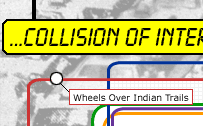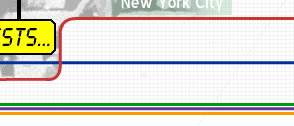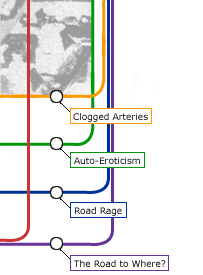



In-Line Skating in Everyday Manhattan Life || Towards a Pedestrian Agenda
PRT Safety and Security
Thomas H. Floyd Jr.
To be accepted by the public, any new form of transportation must be safe and secure. A perfectly "safe" system would never kill or injure someone who is using, observing, or working on it. A perfectly "secure" system would never allow someone else to kill or injure someone who is using it.
The safety of automobiles leaves a lot to be desired. They kill and maim an alarming number of human beings (and other life) each year. So why is their poor safety record still tolerated as much as it is? In part, because the door-to-door private service that automobiles offer makes them very secure.
In contrast, the safety of common carriers -- airlines, railroads, ships, and mass transit -- is remarkably high. It is in security -- not safety -- that common carriers lag behind the automobile. With mass transit, for instance, individuals may not feel or be secure walking to and waiting at transit stops and stations after dark and in less-populated or threatening places. Subway cars are not always attended by transit authorities or police officers, leaving riders unprotected.
Well-designed personal rapid transit (PRT) systems could be even safer and much more secure than traditional mass-transit systems. The many small stations, for example, would be closely spaced, often connected directly to buildings. This would allow short and relatively secure walks to stations. Those stations that were not staffed -- normally a majority -- would be small and well-lighted, with clean lines of sight that could be monitored by closed-circuit television. Emergency alarm buttons and two-way communication in the stations would allow an individual feeling threatened to contact a control center monitoring the station.
Passengers would typically be able to board a vehicle immediately and ride alone or with persons of their choice. An alarm button inside the vehicle could be pressed if, for example, a medical emergency arises or an intruder forces his way into the vehicle directly to a secure location where police, health, or other assistance would be available. Two-way communication between passenger and control center would be possible at all times.
Some critics have argued that PRTs would be vulnerable to accidents because the individual vehicles would be too closely spaced on the track -- much closer than traditional transit vehicles. During peak periods, PRT vehicles might travel at one or two second intervals;in some high-capacity systems, the intervals would be even shorter. (Automobiles frequently travel at such close spacings but under much less controlled conditions.) The relatively small size and low weights of PRT vehicles and the technological advances in automatic control technologies have made this close spacing possible.
Automatic controls would be designed on fail-safe and fail-soft principles, with redundant critical components. PRT vehicles would be designed and operated to avoid crashes. Equally important, they would be designed so that a crash would not kill or seriously injure a passenger -- a feature that is not economically feasible in large mass-transit vehicles or automobiles. In the small PRT vehicle, all passengers would be seated (no standees), smooth interior surfaces and air bags would be standard, and the front and rear ends of vehicles would have energy-absorbing bumpers.
Vehicles would have, in addition, sensors in the front, rear, and on the sides to detect anomalies. Detection of a problem would immediately trigger defensive reactions either by the vehicle itself or by system control.
PRT stations and vehicles would be constructed form fire proof materials, with the vehicle's motive power, braking, and control elements separated from the passenger compartment by a fireproof divider. Such complete separation is difficult and frequently impossible in the large vehicles of mass transit, especially when they operate in trains. Safety from fire could be higher in PRT, therefore, than in traditional mass transit. Should a fire break out, it would be isolated to a single vehicle, rather than threatening a whole system.
The possibility that vehicles might occasionally be stalled, damaged, or in danger on the track has given rise historically to some demands that passenger emergency walkways be added to PRT guideways. A safer solution (because of the added danger to passengers in abandoning vehicles and trying to walk on elevated track) would probably be for passengers to remain in the vehicle while it is slowly pushed to the next station by another PRT vehicle that engages it from behind. In an unusual emergency, a "cherry picker" service vehicle could remove passengers to safety.
Back to top